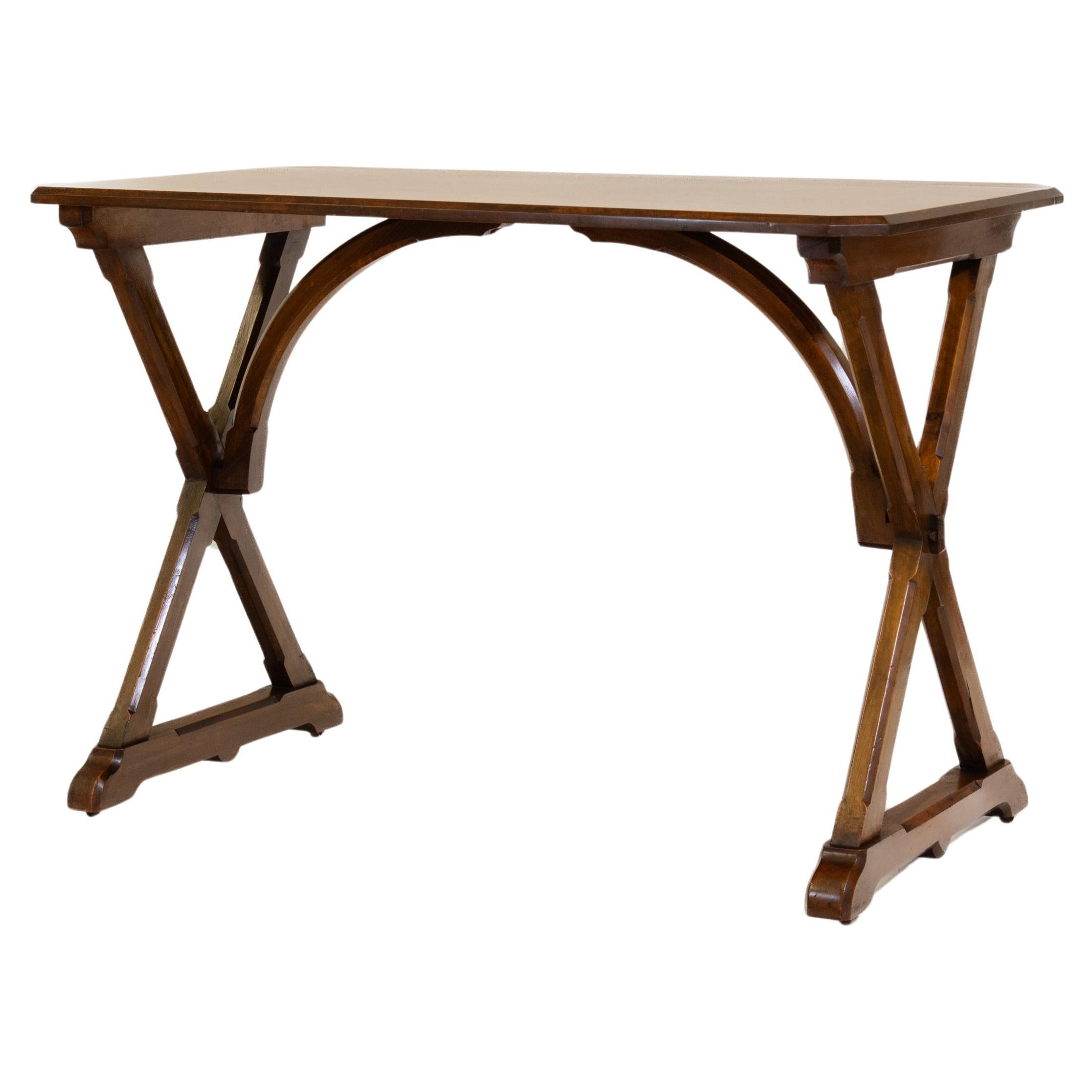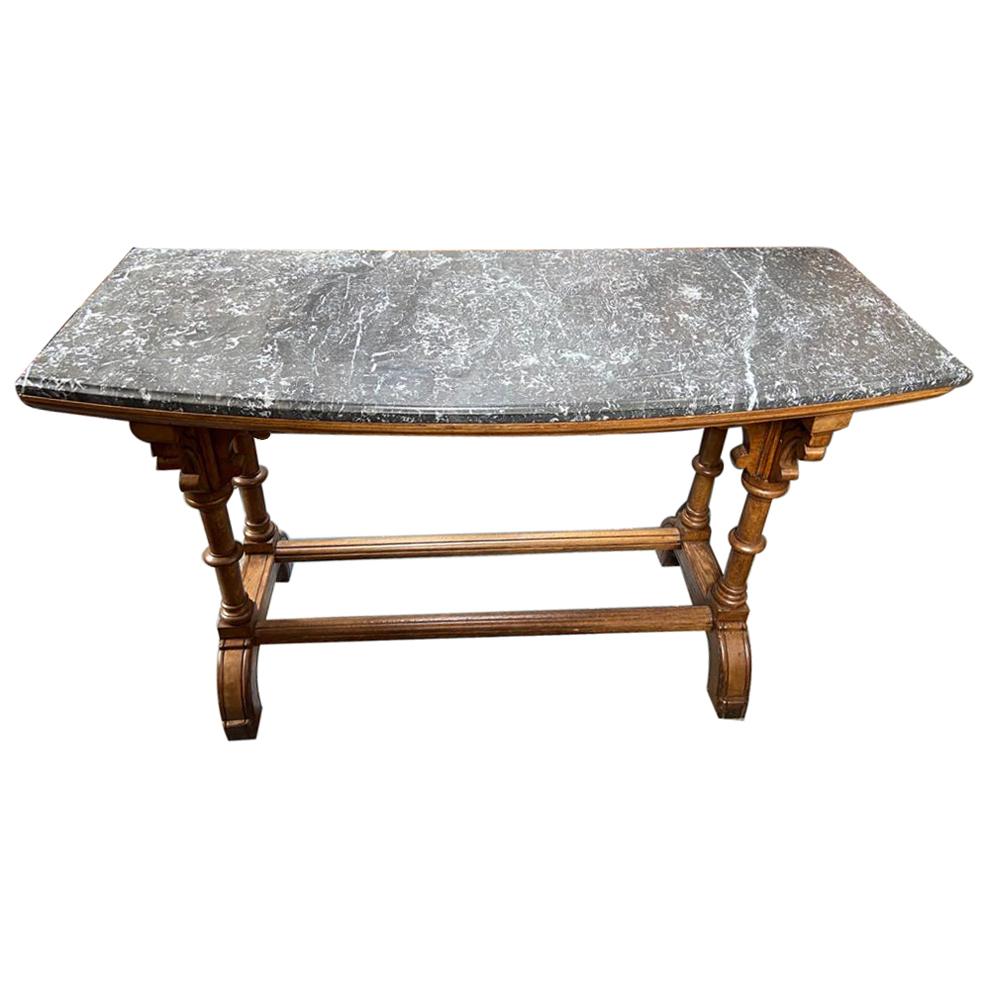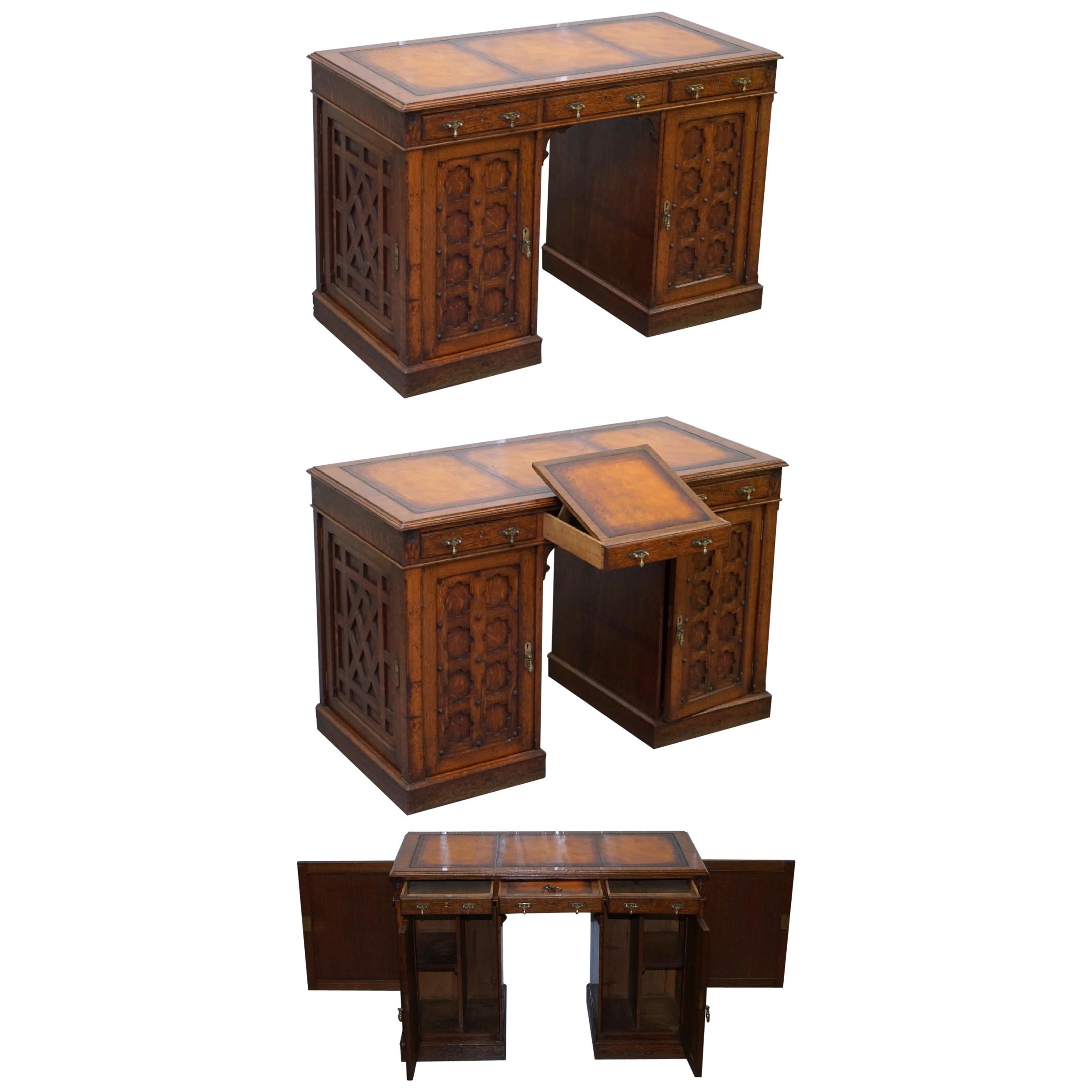Items Similar to A.W.N Pugin and Sir Charles Barry, an Important Gothic Revival Oak Library Table
Want more images or videos?
Request additional images or videos from the seller
1 of 21
A.W.N Pugin and Sir Charles Barry, an Important Gothic Revival Oak Library Table
About the Item
A.W.N Pugin and Sir Charles Barry.
A rare and important Gothic Revival carved oak library table. Probably one of the earliest known pieces to derive from the illustrious relationship with Sir Charles Barry, some five years before they began work on the Houses Of Parliament together. Sir Charles Barry designed the relatively simple Tudor Gothic/Elizabethan house East Horsley Park for William Currie in 1834. Pugin, from April 1835 worked for Barry, assisting him with some of the interiors, including furniture of his (Barry’s) King Edward VI Grammar School Birmingham. Pugin assisted Barry with Trentham Church and with the interior of Horsley Towers for Currie; this being first noted by Phoebe Stanton in her Courtauld Institute Ph.D on Pugin (1950).
The Currie family sold the estate in the early 1840s to the eccentric Lord Lovelace (1805-1893) who (Sir John and Lady Kirkland who were tenants having moved out in early 1845) lived there from circa 1846 to his death and was responsible for the fanciful Gothic/Byzantine work there (Great Hall is dated 1847 and west tower is of late 1840s, east tower 1858 and cloisters 1859. The chapel is 1860 and an additional storey to the south side was also added by Lovelace. Lovelace’s style in the late 1850s is clearly very different (in part due to his having travelled abroad) to his earlier work at the house.
Phoebe Stanton was the first to state Pugin worked for Barry on the interiors/furniture at East Horsley Park in her 1950 Ph.D. It has therefore been generally known that Pugin worked for Barry on East Horsley Park.
David Blissett included this project in his own Ph.D of 1984, in which he included the illustrations attached of Barry’s scheme of the house and a tracing of what is clearly a group of designs for furniture by Barry/Pugin. Given the design, date and scale of the furniture in these tracings it has been suggested they were for the relatively small-scale East Horsley Park and are by Barry/Pugin circa 1835. Before Lovelace took up residence the house was let out, but it is not clear yet whether it was let out by the Curries or Lovelace. One of the points to note in the lettings details is that it was to be let furnished. David therefore strongly suspects some of the Barry/Pugin furniture that was specifically designed for the house circa 1835 was left in the house not only when it was let, but when it was sold to Lovelace circa 1840. Lovelace, in his inimitable manner, then proceeded 1847/8 to reinvent, much to Barry’s horror, the relatively modest Gothic house Barry had created for Currie. Barry was so annoyed by this vandalism that he turned his back on the project.
The 1st Earl of Lovelace was raised to that Peerage in Queen Victoria's Accession Honours list of 1838. Three years earlier in 1835 Lovelace married Ada Byron, becoming Countess of Love. She was the only daughter of the celebrated poet Lord Byron. She was an important figure, a mathematician and writer, who is known for her work on Charles Babbage's early mechanical computer and is often regarded as the first computer programmer. Ada described in her notes how codes could be created for the device to handle letters and symbols along with numbers. She also theorized a method for the engine to repeat a series of instructions, a process known as looping that computer programs use today. Ada also offered up other forward-thinking concepts in the article.
In her later years, she tried to develop mathematical schemes for winning at gambling. Unfortunately, her schemes failed and put her in financial peril.
Ada died in 1853 at the age of 37.
I would like to thank David and Rachel Blissett for the information regarding Barry and Pugin working together on East Horsley Park and for the drawings and paragraphs in the images.
- Creator:Augustus Welby Northmore Pugin (Designer)
- Dimensions:Height: 31 in (78.74 cm)Width: 60 in (152.4 cm)Depth: 34 in (86.36 cm)
- Style:Gothic Revival (Of the Period)
- Materials and Techniques:
- Place of Origin:
- Period:
- Date of Manufacture:1835
- Condition:Wear consistent with age and use. The leather top has been replaced. The fabric on the floor stretcher is original. Small chip to one foot just up from the Tudor rose.
- Seller Location:London, GB
- Reference Number:1stDibs: LU2243312592871
About the Seller
5.0
Platinum Seller
These expertly vetted sellers are 1stDibs' most experienced sellers and are rated highest by our customers.
Established in 1989
1stDibs seller since 2016
237 sales on 1stDibs
Typical response time: <1 hour
- ShippingRetrieving quote...Ships From: London, United Kingdom
- Return PolicyA return for this item may be initiated within 3 days of delivery.
More From This SellerView All
- A.W.N. Pugin, J C Crace Gothic Revival Carved Oak Library, Hall or Serving TableBy Augustus Welby Northmore PuginLocated in London, GBA.W.N. Pugin. A rare Gothic Revival carved oak library or serving table with floor level display shelf. Probably made by J C Crace. Pugin used a number of recurring motifs, on furnit...Category
Antique 1850s English Gothic Revival Serving Tables
MaterialsOak
- A.W.N Pugin Style of a Gothic Revival Oak Coal Purdonium with Linen Fold CarvingBy Augustus Welby Northmore PuginLocated in London, GBA.W.N Pugin style of a Gothic Revival oak coal purdonium with seed carving to the edge of the top and linen fold carvings to the front and to the sides with blind fret details to the...Category
Antique 1880s English Gothic Revival Fireplace Tools and Chimney Pots
MaterialsOak
- A.W.N. Pugin, A pair of Early Gothic Revival Cast Iron Garden Bench EndsBy Augustus Welby Northmore PuginLocated in London, GBA rare pair of early Gothic Revival cast iron garden bench ends designed by A.W.N. Pugin with foliage details which is slightly obscured at the moment due...Category
Antique 1850s Great Britain (UK) Gothic Revival Patio and Garden Furniture
MaterialsIron
- Charles Bevan, Attri. A Gothic Revival Oak Library or Sofa Table with Marble TopBy Charles Bevan, John Marsh and Edward JonesLocated in London, GBCharles Bevan, attri. probably made by Marsh Jones and Cribb of Leeds. A super quality Gothic Revival oak library or Sofa table with semi-circular veined marble top, arched supports...Category
Antique 1880s English Gothic Revival Serving Tables
MaterialsMarble
- A W N Pugin. A modern craftsman made Gothic Revival oak octagonal centre tableBy Augustus Welby Northmore PuginLocated in London, GBA W N Pugin after a design by. A modern craftsman made Gothic Revival oak octagonal centre table with a central upright turned column that passes through the arched legs uniting the ...Category
Vintage 1980s English Gothic Revival Side Tables
MaterialsOak
- A W N Pugin Attri, Gothic Revival Oak Davenport with Linenfold & Floral CarvingBy Augustus Welby Northmore PuginLocated in London, GBA W N Pugin attributed, A Gothic Revival Oak Davenport with finely executed carved gallery to the top and a sloping writing area opening to reveal storage...Category
Antique 1860s English Gothic Revival Desks
MaterialsOak
You May Also Like
- 19th Century Gothic Revival Walnut Writing Side Table A W Pugin MannerBy Augustus Welby Northmore PuginLocated in Norwich, GBA 19th Century burr walnut and walnut Gothic Revival writing side table in the A W Pugin manner. English. Circa 1860. The table having a burr walnut top with canted corners, support...Category
Antique 19th Century English Gothic Revival Desks and Writing Tables
MaterialsWalnut, Burl
- Restored Gothic Revival Desk Side Bookcases Drawer Writing Slope Pugin GillowsBy Pugin, Gillows of Lancaster & LondonLocated in GBWe are delighted to offer for sale this exceptionally rare Gothic Revival circa 1840 solid oak partner desk with top drawer writing slope and side bookcases made by either Gillows of Lancaster or Pugin Where to begin, this desk has been on a journey, when I first received the piece it looked like it had been French polished and waxed around 20 times, it had a very clumpy sticky finish, my restorers have stripped back all that horrible guck, they have then lightly stained and French polished it the correct way which has kept all the period patina and simply made it golden, The leather top and writing slope top has been replaced with fully aniline natural cattle hide leather that was plain, I’ve then had my leather polishers dye it this gorgeous whisky brown colour. Lastly there was various small timber repairs which have been done with antique timber...Category
Antique 1840s English Gothic Revival Desks and Writing Tables
MaterialsLeather, Oak
- Antique Estate Desk, Scottish, Oak, Library Table, Gothic Revival, VictorianLocated in Hele, Devon, GBThis is an antique estate desk. A Scottish, oak library table with leather skiver in Gothic revival taste, dating to the Victorian period, circa 1880. W...Category
Antique Late 19th Century Scottish Desks and Writing Tables
MaterialsOak
- Large Scale Victorian Ecclesiastical Gothic Revival Table in the Manner of PuginBy Augustus Welby Northmore PuginLocated in Llanbrynmair, GBA superb 19th century Gothic Revival centre table in the manner of A.W.N Pugin (unattributed). Would make a wonderful serving table or large console table. Narrow form make this piec...Category
Antique 19th Century British Gothic Revival Center Tables
MaterialsOther
- Gothic Revival Hand-Carved Oak Pedestal Desk, 1900sLocated in Amsterdam, NLMagnificent and ultra rare Gothic Revival pedestal desk. Striking Dutch design from the 1900s The craftsmanship of this impressive piece of furniture is outstanding! Executed in so...Category
Antique Early 1900s Dutch Gothic Revival Desks and Writing Tables
MaterialsOak
- Neo-Gothic Oak Writing TableLocated in Bradford-on-Avon, WiltshireA rare neo-Gothic writing table with superb carved detail mainly in a foliate design: striking pointed-arch pierced ends and carved stretcher, knobs and escutcheon; the rectangular t...Category
Antique Mid-19th Century English Gothic Revival Desks and Writing Tables
MaterialsOak
Recently Viewed
View AllMore Ways To Browse
Important Estate
Important Desk
Oak Library
Library Tables And Desks
Used School Desks Desks
School Desks Used
School Desk Used
Antique Library Table Desk
Antique Gothic Table
Gothic Antique Tables Gothic Tables
Antique School Table
Estate Desk
Oak Library Table
Library Table Oak
Antique Oak Other Tables
Small Antique Oak Side Table
Used Victoria Tables
Used Victoria Table





